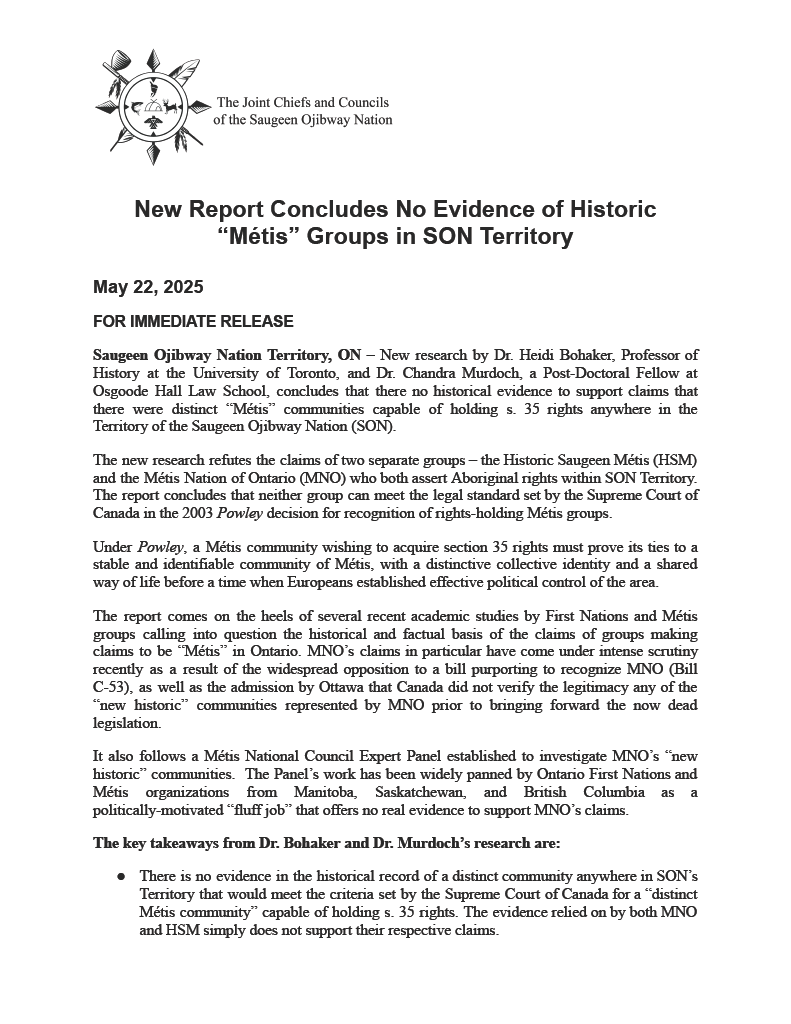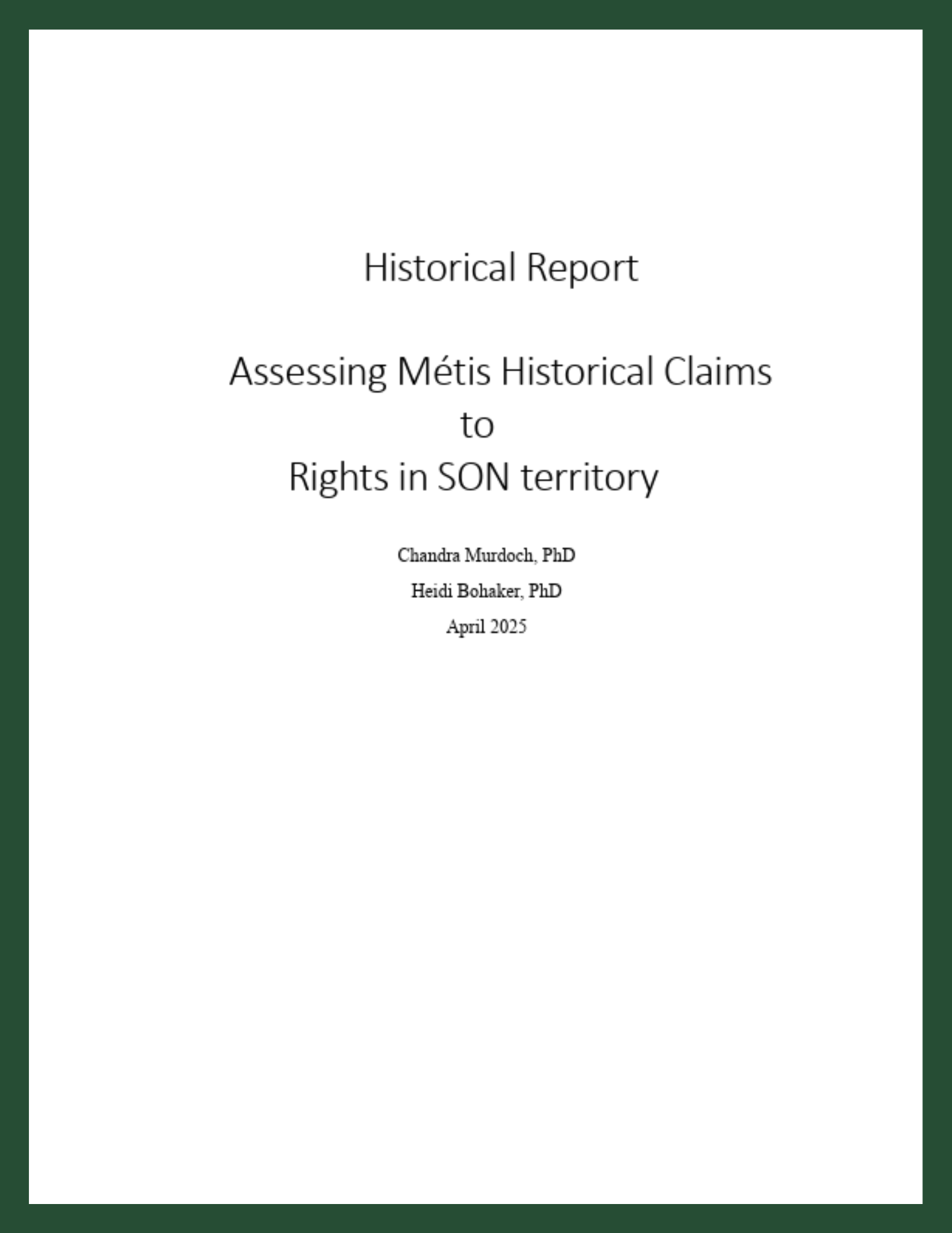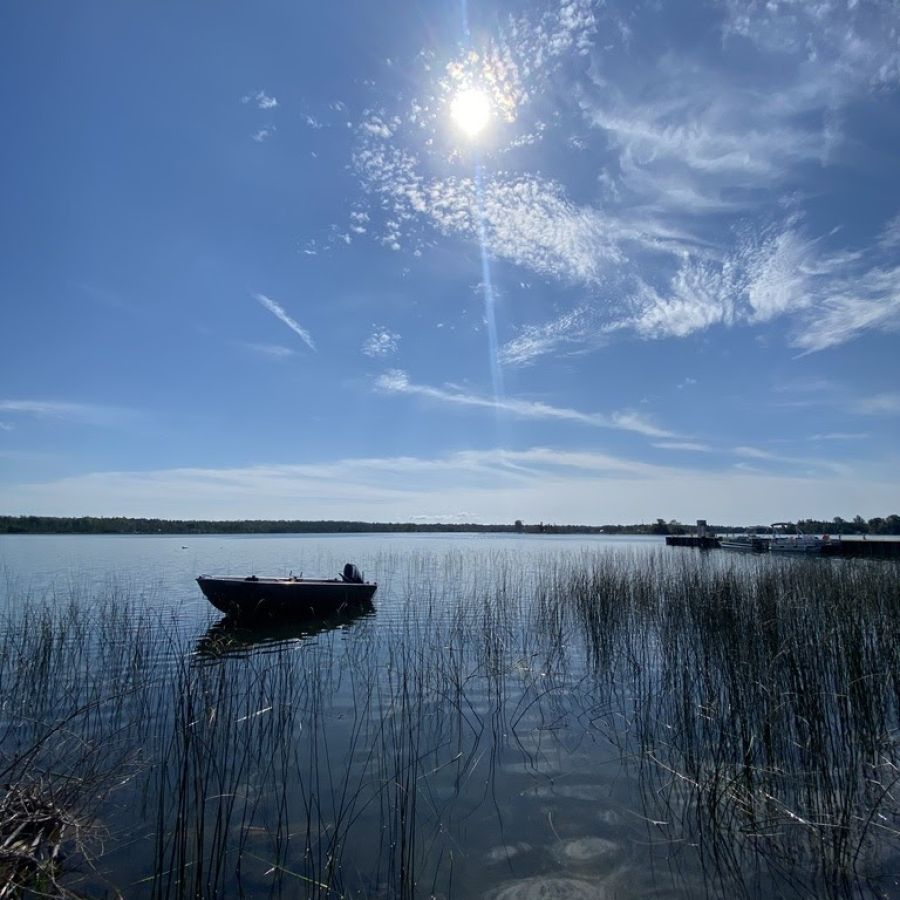New Report Concludes No Evidence of Historic “Métis” Groups in SON Territory
FOR IMMEDIATE RELEASE

Saugeen Ojibway Nation Territory, ON – New research by Dr. Heidi Bohaker, Professor of History at the University of Toronto, and Dr. Chandra Murdoch, a Post-Doctoral Fellow at Osgoode Hall Law School, concludes that there no historical evidence to support claims that there were distinct “Métis” communities capable of holding s. 35 rights anywhere in the Territory of the Saugeen Ojibway Nation (SON).
The new research refutes the claims of two separate groups – the Historic Saugeen Métis (HSM) and the Métis Nation of Ontario (MNO) who both assert Aboriginal rights within SON Territory. The report concludes that neither group can meet the legal standard set by the Supreme Court of Canada in the 2003 Powley decision for recognition of rights-holding Métis groups.
Under Powley, a Métis community wishing to acquire section 35 rights must prove its ties to a stable and identifiable community of Métis, with a distinctive collective identity and a shared way of life before a time when Europeans established effective political control of the area.
The report comes on the heels of several recent academic studies by First Nations and Métis groups calling into question the historical and factual basis of the claims of groups making claims to be “Métis” in Ontario. MNO’s claims in particular have come under intense scrutiny recently as a result of the widespread opposition to a bill purporting to recognize MNO (Bill C-53), as well as the admission by Ottawa that Canada did not verify the legitimacy any of the “new historic” communities represented by MNO prior to bringing forward the now dead legislation.
It also follows a Métis National Council Expert Panel established to investigate MNO’s “new historic” communities. The Panel’s work has been widely panned by Ontario First Nations and Métis organizations from Manitoba, Saskatchewan, and British Columbia as a politically-motivated “fluff job” that offers no real evidence to support MNO’s claims.
The key takeaways from Dr. Bohaker and Dr. Murdoch’s research are:
- There is no evidence in the historical record of a distinct community anywhere in SON’s Territory that would meet the criteria set by the Supreme Court of Canada for a “distinct Métis community” capable of holding s. 35 rights. The evidence relied on by both MNO and HSM simply does not support their respective claims.
- The MNO’s claim to all of SON Territory is based on four mixed ancestry families arriving and living in Owen Sound as part of the Euro-Canadian community after Europeans established legal and political control of the area.
- HSM assertion there was a historic Métis community centred around Southampton and Goderich is based on small group of six mixed ancestry families that stayed in that area for a sustained period. All of these individuals arrived as part of the colonization of SON’s Territory, and some of the very family lines HSM relies on were the beneficiaries of SON’s dispossession.
- Given the “longstanding and assertive” Anishinabe governance of SON Territory, it would have been close to impossible for SON not to know about the existence of a distinct “Métis” community, and there is no evidence of any nation-to-nation recognition of HSM or MNO by the Anishinaabe.
“This report highlights what we have always known – that the Anishinaabe are the only people with rights and responsibilities in our Territory. As Anishinaabe, we have an obligation to protect the land, waters, and resources of our Territory for our people, including from false claims by groups like MNO and HSM,” said Chief (Ogimaa) Conrad Ritchie, the Chief of Saugeen First Nation.
“Governments and proponents who give credibility to these false claims cause real harm by diverting resources meant for First Nations,” said Chief (Ogimaa) Greg Nadjiwon of Chippewas of Nawash First Nation. “Living in a place is not the same thing as being Indigenous to a place. The evidence is crystal clear. We call on Canada and Ontario to stop enabling these groups and instead start negotiating with SON to protect our long-established rights.”
About the Saugeen Ojibway Nation
The Saugeen Ojibway Nation is made up of two First Nations: the Chippewas of Nawash Unceded First Nation and the Saugeen First Nation. Their shared Territory includes the Bruce (Saugeen) Peninsula, 1.5 million acres of lands south of the Peninsula, and the surrounding waters of Lake Huron and Georgian Bay. The Saugeen Ojibway Nation are the Crown’s Treaty partners under Treaty 45 ½ and Treaty 72 and other Treaties.
Media Contacts:
Janet Galant, Senior Manager Saugeen Ojibway Nation Environment Office
Lacey Thompson, Communications Coordinator, Saugeen Ojibway Nation Environment Office
Rachel Renfrew, Communications, Chippewas of Nawash Unceded First Nation
Justine Kaufman, Communications, Saugeen First Nation
Krista Nerland, OKT Law
Click Here to View the Full PDF


